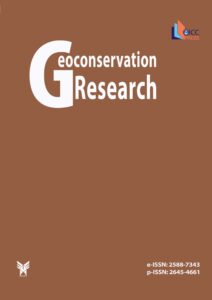Erratum: Azores UNESCO Global Geopark: Where Volcanoes Tell Us Their Stories
Authors
- Eva Almeida Lima * 1
- Salomé Meneses 2, 3
Abstract
The Azores UNESCO Global Geopark, located in the North Atlantic Ocean is a volcanic archipelago with several non-inhabited islets and nine inhabited islands. The 27 volcanic systems with polygenetic central volcanoes and volcanic ridges, most of them active but dormant, represent an exuberant geological heritage, most of which (77% of geosites) is protected. The quantity and quality of the Azorean geosites, their international relevance, and high range of geodiversity, together with the rich biodiversity and the notable cultural heritage of the archipelago sustain the Azores UNESCO Global Geopark through the motto “Nine Islands – One Geopark”. The Azores Geopark, the first archipelagic geopark in the world, is established on the basis of 121 geosites distributed across the nine islands and surrounding marine area. The unique geological and geographical setting of the archipelago allowed the development of outstanding landscapes and a culture that is deeply linked to volcanic eruptions and earthquakes. One of the priorities of the geopark is to provide the tools and knowledge for sustainable use of this heritage through geotourism. Here, we review the Geopark, and introduce a new geosite, the Ponta da Ajuda, the largest and best outcrop of columnar jointing on São Miguel island.
Read the full text of the articleKeywords
References
Chovelon P (1982). Évolution volcanotectonique des iles de Faial et de Pico, Archipel des Açores - Atlantique Nord. Thèse de Docteur 3ème Cycle, Université de Paris-Sud, Centre D’Orsay.
Laughton AS & Whitmarsh RB (1974). The Azores-Gibraltar Plate Boundary. In Kristjansson L(eds) Geodynamics of Iceland and the North Atlantic Area. NATO Advanced Study Institutes Series (vol 11). Springer, Dordrecht. https://doi.org/10.1007/978-94-010-2271-2_5.
Lima EA (2007). Geological Heritage of the Azores: Valorization of Sites with Geological Interest of Environmental Areas, Contribution to Spatial Planning. Master’s degree in Spatial Planning and Environmental Planning, University of the Azores.
Lima EA (2018). Definition of Geological Heritage Management Methodology. Application to the Azores Archipelago. PhD Thesis on Environmental Geology, University of the Azores.
Lima EA & Machado M (2018). Geotourism in the Azores UNESCO Global Geopark, Portugal. In Handbook of Geotourism. Ross Dowling & David Newsome (editors). (pp 320-328). Australia, Edward Elgar Publishing. https://doi.org/10.4337/9781785368868
Lima EA & Nunes JC (2014). Caracterização geomorfológica dos geossítios do Geoparque Açores. [Proceedings of] I Encontro Luso-Brasileiro de Património geomorfológico e geoconservação (pp. 56-61). ISBN: 978-989-96462-5-4.
Lima EA, Machado M, Guerreiro M, Nunes JC & Costa MP (2018). Geological heritage management in small islands: The example of the Azores UNESCO Global Geopark (Portugal). Geoheritage. 10: 659–671. https://doi.org/10.1007/s12371-018-0328-6
Lima EA, Nunes JC, Costa MP & Machado M (2014). Basis for the geological heritage management in the Azores Archipelago (Portugal). Journal of Integrated Coastal Zone Management. 14(2): 301-320. https://doi.org/10.5894/rgci484
Moore RB (1990). Volcanic geology and eruption frequency, São Miguel, Azores. Bulletin of Volcanology. 52; 602-614.
Moore RB (1991). Geologic Map of São Miguel, Azores. Escala 1:50 000. In: Miscellaneous Investigation Series. U. S. Department of the Interior, U. S. Geological Survey (Ed.).
Nunes JC (2002). Novos Conceitos em Vulcanologia: Erupções, Produtos e Paisagens Vulcânicas. Geonovas. 16: 5-22.
Nunes JC & Lima EA (2008). Paisagens Vulcânicas dos Açores: Valor Intrínseco Enquanto Recurso Natural e Património Geológico. [In Abstract Book] IV Congresso Nacional de Geomorfologia (pp. 31). Braga, Portugal.
Ramalho R, Helffrich G, Madeira J, Cosca M, Thomas C, Quartau R, Hipólito A, Rovere A, Hearty P & Ávila S. (2017). Emergence and evolution of Santa Maria Island (Azores) - The conundrum of uplifted islands revisited. Geological Society of America Bulletin. 129: 372–391.
Santos P, Nunes JC, Meneses S & Costa MP (2022). Inventory and prioritization of geological sites of Azores Islands: a review based on its scientific value and a contribution to the valorisation of geotourism in the Azores UGGp. (In: Proceeding of ) 16Th European Geopark Conference, 2022. Verbania.
Searle R (1980). Tectonic pattern of the Azores spreading centre and triple junction. Earth and Planetary Science Letters. 51: 415-434.
Sigurdsson H, Houghton BF, McNutt SR, Rymer H & Stix J (2000). Encyclopedia of Volcanoes. San Diego: Academic Press.



